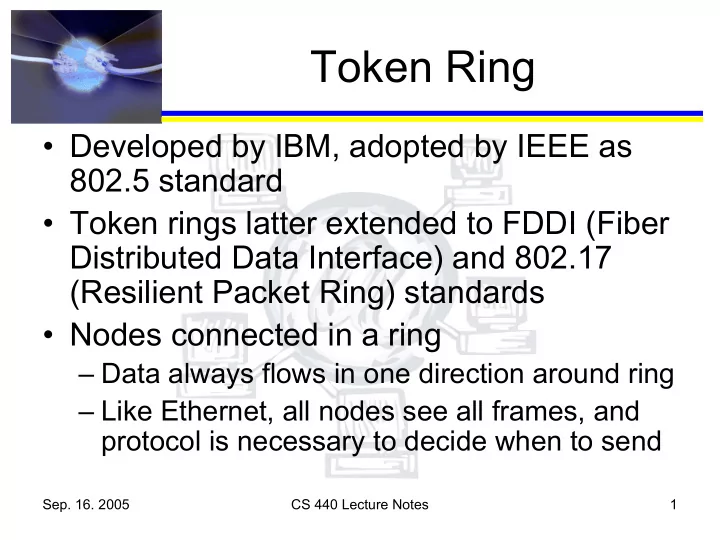

Token Ring • Developed by IBM, adopted by IEEE as 802.5 standard • Token rings latter extended to FDDI (Fiber Distributed Data Interface) and 802.17 (Resilient Packet Ring) standards • Nodes connected in a ring – Data always flows in one direction around ring – Like Ethernet, all nodes see all frames, and protocol is necessary to decide when to send Sep. 16. 2005 CS 440 Lecture Notes 1
Tokens • Token ring named because token (a special sequence of bits) is passed around the ring – Each node receives and retransmits token – A node with something to transmit can take token off ring and insert frame – Destination node copies frame, but sends on – When sender receives frame, node drops it and reinserts the token – All nodes get chance to transmit (round-robin) Sep. 16. 2005 CS 440 Lecture Notes 2
Physical Properties • Nodes connected to ring using electro- mechanical relay – Prevents node failure from crashing ring • Several relays often packed into one multi- station access unit (MSAU) – Provide easy addition and removal of nodes – Required by IBM Token Ring, not 802.5 Sep. 16. 2005 CS 440 Lecture Notes 3
Physical Properties (cont.) • Data rate either 4 or 16 Mbps • Uses Manchester encoding • IBM Token Rings can have up to 260 stations per ring, 802.5 up to 250 • Physical medium for IBM is twisted pair, not specified for 802.5 Sep. 16. 2005 CS 440 Lecture Notes 4
Media Access Control • Each node includes receiver, transmitter, one or more bits of memory between • Ring must contain enough memory to hold entire ring – 802.5 token is 24 bits long, so if each station can hold only 1 bit, must have at least 24 stations, or more than one bit-time distance between stations – Alternative is monitor station that adds delay Sep. 16. 2005 CS 440 Lecture Notes 5
Seizing token • When node wants to send, modifies one bit in second byte of token – this changes first two bytes into transmission preamble • Station then inserts one or more packets onto ring • Each packet contains destination address, can also contain multicast or broadcast address Sep. 16. 2005 CS 440 Lecture Notes 6
Receiving • If node recognizes address, copies data from transceiver into buffer, but still forwards it • Sending station responsible for removing packet from the ring • Station might be draining first part of packet from ring while transmitting end of packet, if ring is small enough Sep. 16. 2005 CS 440 Lecture Notes 7
Transmission Limits • Control how long sender can transmit ( token hold time , THT) • The more bits a node can send, the better the ring utilization, but the poorer the response time for other nodes • In 802.5, THT defaults to 10 ms – Sender responsible for knowing how long it has already held token, how long next packet will take to transmit Sep. 16. 2005 CS 440 Lecture Notes 8
Transmission Limits (cont.) • Nodes also compute token rotation time (TRT) – TRT ≤ ActiveNodes * THT + RingLatency – ActiveNodes are # that have data to send – RingLatency is time to send token around ring if no node has anything to send Sep. 16. 2005 CS 440 Lecture Notes 9
Reliable Delivery • Receiver sets the A bit in packet trailer if it recognizes itself as addressed node • Sets the C bit in the trailer when it finishes copying packet into its buffer • Sender can check for missing A or C bits when it gets packet back to verify that sender was there and was able to buffer entire packet Sep. 16. 2005 CS 440 Lecture Notes 10
Priority • Token includes 3-bit priority field – Each device assigns priority to each packet it needs to send – Only captures token if packet priority >= token’s • Frame header includes 3 reservation bits – Node X can set reservation bits to priority of its packet if bits don’t already have >= value – Token holder escalates priority to that value when it releases token – Node X must reset priority to old value when done Sep. 16. 2005 CS 440 Lecture Notes 11
Ring Maintenance • Any node can become monitor – Procedure defined to elect monitor when ring first connected or monitor fails • Monitor periodically announces its presence • If this is missed, another station will send claim token to attempt to become monitor – Tie broken by rule like “highest address wins” – If sender gets claim back, it becomes monitor Sep. 16. 2005 CS 440 Lecture Notes 12
Ring Monitor • Monitor can insert delay into ring if needed • Makes sure that there is always a token – Timeout after NumStations*THT+RingLatency – Generate new token • Removes packets if sender dies – Monitor bit in header set first time packet passes monitor – Packet with bit set is removed by monitor Sep. 16. 2005 CS 440 Lecture Notes 13
Ring Monitor (cont.) • Also detects dead stations – Catch more subtle errors than MSAU switch – Send beacon packet to suspected dead node – Instruct MSAU to bypass malfunctioning node Sep. 16. 2005 CS 440 Lecture Notes 14
Frame Format 8 8 8 48 48 Variable 32 8 8 Dest Src End Frame Start Access Frame Body CRC Address Address Delimiter Status Delimiter Control Control • Start and end delimiters use invalid Manchester codes • Access control includes priority and reservation bits • Frame control indicates higher level protocol Sep. 16. 2005 CS 440 Lecture Notes 15
Frame Format (cont.) • Addresses identical to Ethernet addresses – Standard allows for 16-bit addresses, but they are not typically used • Frame status byte includes A and C bits Sep. 16. 2005 CS 440 Lecture Notes 16
Recommend
More recommend